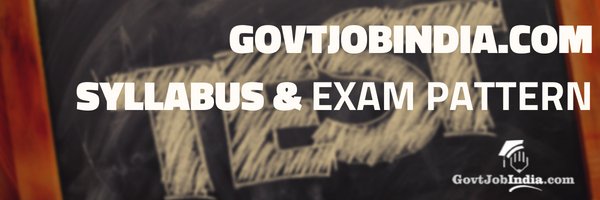TN MRB Assistant Surgeon Exam Syllabus 2018 | Download Tamil Nadu TN MRB Assistant Surgeon Exam Syllabus and Paper Pattern pdf 2018 – உதவியாளர் அறுவை தேர்வு பாடத்திட்டம் 2018
 TN MRB Assistant Surgeon Syllabus 2018: Candidates can download the TN MRB Assistant Surgeon Syllabus pdf and Exam Pattern on this page. Tamil Nadu MRB Assistant Surgeon General Exam is expected to be highly competitive and as such candidates can utilize the Syllabus pdf provided in this article to assist them in their exam preparation. Likewise, candidates should also check out the TN MRB Assistant Surgeon Exam Pattern 2018 for the subject wise marks distribution.
TN MRB Assistant Surgeon Syllabus 2018: Candidates can download the TN MRB Assistant Surgeon Syllabus pdf and Exam Pattern on this page. Tamil Nadu MRB Assistant Surgeon General Exam is expected to be highly competitive and as such candidates can utilize the Syllabus pdf provided in this article to assist them in their exam preparation. Likewise, candidates should also check out the TN MRB Assistant Surgeon Exam Pattern 2018 for the subject wise marks distribution.
The TN MRB Assistant Surgeon General Exam is set to be conducted on 9th December 2018. Candidates can download the MRB Assistant Surgeon Syllabus pdf to have constant access to the Syllabus at their fingertips.
The MRB Assistant Surgeon Syllabus pdf provided here s 100% accurate with respect to the official Assistant Surgeon pdf provided on the official Website of TN MRB @ mrb.tn.gov.in. So candidates can use this TN MRB Asst. Surgeon Syllabus as study material for their MRB Exam 2018.
Consequently, the Exam Pattern provided here is also accurate with respect to the official notification pdf of the TN MRB Assistant Surgeon (General). Candidates can refer this Exam Pattern to get a general idea as to the pattern and marking scheme of the TN MRB Assistant Surgeon General Question Paper.

உதவியாளர் அறுவை ஆட்சேர்ப்பு விவரங்கள் 2018
TN MRB Assistant Surgeon Recruitment Notification 2018 | |
| Recruitment Agency | Tamil Nadu Medical Services Recruitment Board |
| Job Details | 1884 Vacancies |
| Location/State | Tamil Nadu |
| Job Category | Medical Jobs |
| Application Last Date | 15th October 2018 |
| Admit Card Release Date | Will be Announced Soon |
| Written Exam Date | To be declared |
| Application Mode | Online |
| Official Website | mrb.tn.gov.in |
TN MRB Assistant Surgeon Exam Pattern 2018
Provided below is the TN MRB Assistant Surgeon Exam Paper Pattern. Candidates can check out the MRB Assistant Surgeon Exam Paper Pattern for accurate details regarding the Exam paper marks scheme and marks distribution.
Candidates are reminded that the exam will consist of mcq type Questions for a total of 200 marks. Kindly find all the details below.
Subject | Duration | Maximum Marks | Minimum Qualifyingmarks (%) | |
SC/SCA/ST | Others | |||
| Written Exam – MCQs | 2 hours 30 minutes | 100 | 30 % | 35% |
TN MRB Assistant Surgeon Syllabus pdf Download 2018
For all the candidates who want regular access to the TN MRB Assistant Surgeon Syllabus pdf, we have provided the pdf download link below. Candidates can download the TN MRB Assistant Surgeon Syllabus pdf and have it at the tip of their fingertips whenever they desire to access it. Kindly find the Assistant Surgeon pdf attached below.
TN MRB Assistant Surgeon Syllabus pdf download 2018 – CLICK HERE
உதவியாளர் அறுவை தேர்வு பாடத்திட்டம்
TN MRB Assistant Surgeon Syllabus 2018 encloses all the important topics that the candidates can expect in the MRB Assistant Surgeon Exam 2018. You should pay attention to all of these subjects, without omitting a single one. This is because the exam is set to be highly competitive.
Candidates will find the syllabus to be full of familiar subjects. this is because these are all subjects that the candidates have studied during their MBBS Years.
All the details regarding the syllabus are given below.
SYLLABUS FOR EXAMINATION FOR THE POST OF ASSISTANT SURGEON
Medical Sciences-Allopathy: Degree Standard
BASIC MEDICAL SCIENCES ANATOMY
GENETICS:
Structure and function of gene and anatomy of the genome, Classification of genetic disorders, Chromosomal disorders/ Cancer genetics, Genetic counseling, Prenatal diagnosis, Cone therapy.
GENERAL ANATOMY:-
General Embryology, Embryology relating to the Cardiovascular, respiratory, Urogenital, alimentary and Nervous system, Osteology.
APPLIED ANATOMY:-
Cardiovascular System:- Orientation of the heart, Coronary circulation, Nerve supply of the heart, Electrical conduction system.
RESPIRATION SYSTEM:-
Surface anatomy, Gross anatomy, Lobes, Segments, C pleura Mediastinum & Thoracic Cage- Histology, Lung Defences.
ALIMENTARY TRACT AND PANCREAS:-
Teeth/ Oral cavity, Oro- Pharynx- OesophagusAlimentary Tract & Pancreas- blood supply, nervous supply, Lymphatic drainage, Congenital and genetic abnormalities of Alimentary tract and pancreas.
LIVER AND BILIARY SYSTEM.
CONNECTIVE TISSUES, JOINTS & BONES
NERVOUS SYSTEM:-
- Motor System:- Pyramidal system/ Extra Pyramidal system Cerebellum, 2. Sensory system 3. Reflex activity, 4. Control of bladder & Sphincters 5. Cranial Nerves.
LYMPHOID ORGANS:-
Applied Microbiology, Sterilisation, disinfection, Bacterias, Mycobacterium, Fungus, Viral Chlamydial, rickettsial, Streptococcus, Staphylococcus, Corynebacteria, Bacillus, Bordetella, Salmonella, Mycobacteria –TB, Leprae, atypical Mycobacteria, Viruses – RNAArena viruses, Bunyaviruses. Filoviruses, Paramy-Xoviruses, Picornaviruses.(HIV) – Retroviruses, Rhabdoviruses, arboviruses, Togaviruses, DNA- Herpesviruses, Rapoviruses, Poxviruses. Mycoses Cutaneous – Subcutaneous fungal infection systemic fungal infection.
SPIROCHETES;-
Leptospira, Borrelia, Treponema, Immune responses & inflammation, Allergy, Hyper Sensitivity, Transplantation & graft rejection autoimmunity, and protozoa, Helminthes, Anthropods.
APPLIED PATHOLOGY:- Injuries
GENERAL PATHOLOGY:-
Inflammation, Wound healing, Infections, neoplasia, Immuno responses & Inflammation.
I.CARDIOVASCULAR SYSTEM:-
Cardiomyopathy, Pericardial diseases, Valvular diseases, Endocarditis, Aneurysms.
- RESPIRATORY SYSTEM:- Tuberculosis, Chronic Bronchitis & Emphysema, Asthma, Pneumonia, Bronchogenic Carrinomia, Suppurative diseases of the lung, adult respiratory Distress Syndrome:
Respiratory involvement in connective tissue disorder, Trachietis, Laryngitis, Pleural diseases.
III. ALIMENTARY TRACT & PANCREAS
IV. LIVER AND BILIARY SYSTEM
V. MUSCULOSKELETAL SYSTEM
VI. SKIN
VII. RENAL SYSTEM
Glomerular Nephritis, Nephrotic syndrome, Renal failure, Congenital Abnormalities of the Kidneys, Tumours of the kidney & Genitourinary tract, Calculi in the Renal system.
VIII. BLOOD:- Disorders of erythrocytes, Disorders of white cells, Blood transfusion. Haemostasis, Thrombosis, Urogenital system.
- ONCOLOGY
- PATHOLOGY
- NERVOUS SYSTEM – Coma, brain death, cerebral tumors, cerebrovascular, disorders, Parkinsonism, diseases of muscles, Peripheral nerves, spinal cord.
APPLIED BIOCHEMISTRY
Liver Function Tests, Renal Function Tests, Major Electrolyte disorders – Calcium, Phosphate, Magnesium, disorders (Same as in Bio-Chemistry), Acid-Base disorders, Calcium Metabolism, Lipid metabolism, Porphyra.
ENDOCRINE SYSTEM – Hormones estimation, (Hypothalamus/ Pituitary gland), Thyroid Hormones, Parathormone, Corticosteroids, Catecholamines, hyperglycemia/Hypoglycemia.
APPLIED PHYSIOLOGY
CARDIOVASCULAR SYSTEM – Myocardial contraction, factors influencing cardiac output, factors influencing resistance to coronary blood flow/ systemic blood, physiological basis of physical signs.
RESPIRATORY SYSTEM – Ventilation, blood flow and diffusion, lung function tests as applied to obstructive airways/restrictive airways disease.
ALIMENTARY TRACT AND PANCREAS – Controlling/ Coordinating mechanism/ Secretions, absorption, the Defence mechanism.
PHYSIOLOGY OF WATER AND ELECTROLYTES – Major electrolyte disorders, Hypernatraemia, Hyponatraemia, Hypo and Hyperkalaemia, Sodium and water excess
LIVER AND BILIARY SYSTEM – Temperature Regulation, renal function tests, Physiology of skeletal muscle.
ENDOCRINOLOGY – Adrenal Corticosteroids, Antagonist, Corticotrophin, Thyroid hormones, Hypothalami, Pituitary hormones, sex hormones, contraception.
BLOOD – Blood cell formation, stem and progenitor cells, Assessment of hematological parameters.
NERVOUS SYSTEM – Sensory and Motor – Functions, Speech, vision, control of bladder and sphincters, sleep, pain.
APPLIED PHARMACOLOGY
CARDIOVASCULAR SYSTEM – Anti ischaemic drugs (Antianginal drugs), antihypertensives, anti-failure drugs, drugs used in cardiac dysrhythmia, drugs used In shock, hypotension, sympathomimetics, hyperlipidemia, antiarrhythmic drugs.
RESPIRATORY SYSTEM – Antituberculous drugs, antiasthmatic drugs, antibiotics, antifungal, anticancer drugs, cough suppressants, mucolytics, expectorants, antihistamines.
ALIMENTARY TRACT – Pancreas, liver biliary tract, drugs for peptic ulcer, drugs for vomiting, antiemetics and prokinetic drugs, drugs for constipation, misuse of laxatives, drugs for diarrhea, drugs for abnormal gut motility, drugs for inflammatory bowel disease, drug-induced liver injury, drugs used to dissolve gallstones, digestive enzymes.
KIDNEY AND URINARY TRACT – Diuretic drugs, carbonic anhydrase, inhibitors.
ONCOLOGY:- Principles of Management, Principles of Chemotherapy, Principles of Endocrine therapy.
NERVOUS SYSTEM:- Analgesics – Narcotics, Hypnotics/Anxiolytic agents, Classification and dosage of psychotropic drugs, Neuroleptics, Antidepressants, MAOls, Lithium, Psychostimulants, Appetite Control, Amphetamines, Xanthines, Antiepileptics, Antiparkinsonian Drugs, psychodysleptics (or) hallucinogens, Drug Dependence.
ENDOCRINOLOGY:- Adrenal Steroids & their synthetic analogs, Antidiabetic agents – insulin, Oral Hypoglycemic agents, Thyroid Hormones, Antithyroid drugs.
BLOOD:- DRUGS ACTING;- Coagulation System, Fibrinolytic System, Platelets, Iron Therapy, Vitamins – B12 /Folic Acid, Haemopoietic growth factor.
ANESTHESIA AND NEUROMUSCULAR BLOCK:- General Anaesthesia, Pharmacology of Anaesthetic, Inhalation agents, Intravenous anesthetics, Muscle relaxants, Neuro Muscular Blocking Drug Local anesthetics, Obstetric analgesia/ anesthesia, anesthesia in diseased, old age, Childhood, Sedation in intensive therapy units.
ARTHRITIS & ANTIINFLAMMATORY DRUGS.
INFECTION – Chemotherapy, anti-bacterial drugs, chemotherapy of bacterial infections, Chemotherapy of viral, fungal, protozoal and helminthic infection.
DRUGS & SKIN – Vehicles for delivering drugs to the skin, topical analgesia, antipruritics, adrenocortical steroids, Sunscreens, Sunburn, and Photosensors.
POISONING/DRUG OVERDOSE/ANTIDOTES Indiscriminate use of drugs/Antimicrobial in Foetus, Newborn, Infants, adults and in special situations like Hepatitis, Renal problems, Diabetes, etc.
PAPER – II
(INCLUDES General Medicine, Psychiatry, Geriatrics, Paediatrics, Surgery, Gynaecology, Obstetrics
and Community Medicine)
- GENETICS:
- Single Gene Disorders
- Chromosomal disorders
- Multifactorial disorders
- Management, treatment, and prevention of genetic disease.
- IMMUNOLOGICAL DISEASES.
- Climatic and environmental factors producing diseases.
- disorders of heat/cold/altitude/barometric pressure/pollution both indoor and outdoor.
- Diseases due to infections (Bacterial, Viruses, Spirochetes, fungi, protozoa, helminths, arthropods)
- DISEASES OF THE CARDIOVASCULAR SYSTEM:-
Symptoms and signs in a CVS, ECG, exercise-stress, ECG Halter, monitory, radiology, ECHO, cardiac catheterization and angiography, radionucleotide scanning (PET) disorders of heart rate, rhythm and conduction, ischemia, heart disease, vascular disease, diseases of the heart valves, congenital heart, diseases, diseases of the myocardium endocardium, and pericardium.
- DISEASES OF THE RESPIRATORY SYSTEM:-
Symptoms and signs in the respiratory system. Lung function test, spirometry, body box, diffusion studies imaging sciences chest, x-ray, computed tomography, MRI, Ventilation-perfusion imaging, pulmonary angiography, endoscopy-laryngoscopy, bronchoscopy both rigid and flexible, mediastinoscopy, Pleural aspiration & thoracoscopy skin tests. Immunological & Serological, tests, Microbiological, Histopathological and Cytological examinations. Chronic obstructive pulmonary diseases Bronchial Asthma, upper respiratory tract infections, pneumonia tuberculosis. Respiratory diseases caused by fungi, tumors of the bronchus and lung, interstitial and infiltrative pulmonary diseases. Diseases of nasopharynx, larynx, trachea, diseases of pleura, diaphragm and chest wall.
Alimentary tract and pancreas, Hepatobiliary system, symptoms and signs of the alimentary tract, pancreas, hepatobiliary system. Investigations:- Plain radiographs, barium studies, CT, MRI, Arteriography, Interventional radiology, ultrasonography, radionucleotide imaging, endoscopy – (rigid and flexible), sigmoidoscopy, esophagoscope ERCP, Proctoscopy, Biopsies, secretary studies, motility studies, stool examination, liver function tests, diseases of the mouth, esophagus. stomach and duodenum, gastrointestinal hemorrhage, acute abdomen, the disease of the small intestine, irritable bowel disease, diseases of the large intestine, diseases of the pancreas, acute and chronic parenchymal liver disease, tumors of the liver, liver transplantation, liver abscess gallbladder, and other biliary diseases.
- WATER – ELECTROLYTE – ACID-BASE BALANCE DISTURBANCES:-
Serum electrolyte estimation. ABG, Major electrolyte disorders, acid-base disorders, Calcium, phosphate and Magnesium disorders.
- NUTRITIONAL FACTORS IN DISEASE Classification of Nutritional disorders. Energy-yielding Nutrients, Protein Energy Mal-nutrition in -adults -children vitamins, Minerals, Nutrition support in hospital.
- RENAL AND GENITOURINARY SYSTEM Symptoms and signs of renal involvement, Renal function tests. Glomerular diseases, infections of the kidney or urinary tract, obstruction of the urinary tract, urinary tract calculi and nephrocalcinosis, congenital abnormalities of the kidneys, Drugs, and kidney, tumors of the kidney and genitourinary tract.
- ENDOCRINE AND METABOLIC DISEASES INCLUDING DIABETES MELLITUS Symptoms and signs pertaining to various endocrine organs, disorders of Hypothalamus, pituitary gland, thyroid gland, parathyroid gland, adrenal gland, Reproductive organs. Diabetes Mellitus and other metabolic disorders – like lipid, porphyria, etc.
- DISEASES OF THE BLOOD:
Disorders of the erythrocytes, white cells, blood transfusion, hemostasis, venous thrombosis.
- DISEASES OF THE CONNECTIVE TISSUES JOINTS AND BONES Back disorders, Regional periarticular or “soft tissue” disorders, crystal deposition diseases, Inflammatory Joint disease, connective tissue disease, diseases of bone disorders of collagen and proteoglycan and neoplastic disease of bone, Osteoarthritis and related disorders.
- DISEASES OF THE SKIN:
Eczemas, Erythematous scaly eruptions, disorders of the pilosebaceous unit, skin ulceration due to vascular disease, Bullous diseases, skin reactions to light, disorders of pigmentation, hair, and nails and skin tumors.
- PSYCHIATRY:-
Classification of Psychiatric disorders, etiological factors. Causes of acute confusional state, features of alcohol abuse and dependence, the Physical sequence of alcohol abuse, factors associated with increased suicidal risk after deliberate self-harm.
TREATMENTS USED IN PSYCHIATRY:-
Clinical Syndromes – Organic Psychiatric disorders, substance misuse, Schizophrenia, affective disorders, Neurotic, Stress-related and somatoform disorders, eating disorders, sleep disorders, Sexual dysfunctions, puerperal mental disorders, personality disorders, factitious disorders. Special aspects of psychiatry like Psychiatric problems in Hospital and community. Legal aspects of psychiatry.
- DISEASES OF THE NERVOUS SYSTEM:-
Disorders affecting cranial Nerves. (I to XII) cerebral tumors, headache, facial pain, epilepsy, cerebrovascular disorders, movement disorders, demyelinating diseases, Infections of the nervous system. Diseases of the spinal cord, peripheral nerves, muscles, disorders of sleep, degenerative disorders. Nutritional neurological diseases, paraneoplastic neurological syndromes. Investigations of the Nervous system.
CLINICAL EXAMINATION – Imaging – Planning radiology, contrast radiology (angiography – DSA-Digital subtraction angiography) Myelography & radiography, pneumoencephalography, computed tomography, Magnetic Resonance Imaging – MRI – Radio nucleotide cerebral scanning, Emission computed tomography.
CLINICAL NEUROPHYSIOLOGY:-
Electroencephalography(EEG) Evoked Potential Recording Biochemical Tests:- Tests of Muscle breakdown and tests for specific disorders, Tests of autonomic Nervous systems. CSF Examination.
- GERIATRIC MEDICINE:-
Normal old age, Effects of aging on the pharmacokinetics and pharmacodynamics of drugs. Stroke Rehabilitation, Nonspecific presentation of disease in the elderly, common causes of falls, fecal and urinary incontinence in elderly.
- ACUTE POISONING:-
Clinical Features and management of Common acute poisonings. Prevention of acute poisoning.
- EMERGENCY MEDICINE – Cardiopulmonary Resuscitation (CPR), Advanced Cardiac life support(ALLS)
- HIV infection and AIDS.
- Pediatrics:
Growth & development, Nutritional Status, antenatal pediatrics, care of Newborn & premature babies. Immunisation programme – WHO – National, Infant feeding, common birth injuries, diarrhoeal disorders, Acute respiratory infections, Pneumonias – parasitic infections, Neurological disorders, Congenital & acquired cardiovascular, renal & Metabolic disorders, Hepatic & blood disorders, Childhood Malignancies, chromosomal & genetic disorders, Child Survival & Development, Revolution – antenatal care, growth monitoring, oral Rehydration, breast feedings, immunisation etc. Child abuse.
SURGERY:-
Infection, wound healing, water/electrolytes/, Nutrition in surgical patients, shock, Hypothermia, Preoperative and postoperative care, Oxygen therapy, Management of emergencies, Surgical/Orthopaedics, Multiple system injuries, Fractures & dislocation, What first and measures to be adopted? Burns/Organ transplantation, Varicose veins, venous thrombosis, peripheral arterial disease, paronychia, Tenosynovitis, Infection of palmar spaces. Bursitis, amputation, artificial limbs, Breast examination, oral cavity – carcinoma, Head injuries & management at the PHC/district hospital level. Acute abdomen, Pneumothorax, Haemothro, Radiodiagnosis of the emergency conditions – like Du Perforations, fractures etc. Thoracic, abdominal & Pelvic injuries to be recognized, Hernias and Hydrocele. Examination of the patient. Anesthesia in surgery.
GYNAECOLOGY/OBSTETRICS:-
Infection of the genital tract, Tumours of the genital tract, investigations – Pap smear, colposcopy, Colpomicrosopy, fractional curettage, ultrasonography, Laparoscopy, Hysteroscopy, family welfare programme, Breast examination:- Antenatal check up, High Risk Pregnancy, Prevention of low birth weight, babies, Maternal changes during pregnancy in CVS, respiratory system and renal function. PREGNANCY:- Special circumstances – protein Energy Malnutrition, Diabetes, Anaemia, Heart diseases, Malaria, TB, HIV, STD, Infective Hepatitis, Pregnancy and Blood loss, Pregnancy and infection, Pregnancy and Blood transfusion, Anesthesia.
COMMUNITY MEDICINE:-
Health statistics
Epidemiology
Communicable Diseases – Smallpox – influenza – Measles – Typhoid fever – Cholera – Malaria – Rabies anthrax-Nosocomial infections – Food poisoning – Sexually Transmitted Diseases
- Environmental Health and Exposure to chemical
- Hygiene and Sanitation (including rural sanitation)
- Public Health Services.
- Preventive priorities: Hypertension – Family planning – maternal and Child health – Genetic Screening – Surveillance and control of infections diseases – immunization – sexually transmitted diseases – Occupational safety and health Surveillance and control of toxic agents in the Environment Accident prevention and injury control – Smoking – Alcohol and Drug Abuse – Nutrition.
- Principles of Health Education.
- Regional and National health Programmes including social, maternity and Child Health, more emphasis on population/HIV/Leptospirosis, tropical diseases, mother and child health care programme WHO PROGRAMME.
MANAGEMENT OF EMERGENCIES:-
- To manage acute anaphylactic shock
- Providing assistance during perivascular failure and shock
- To manage Acute Pulmonary Oedema and LVF.
- Emergency management of Drowning, Poisoning, and Seizures
- Urgent Management of Bronchial Asthma & status Asthmaticus.
- Emergency Management of Hyperpyrexia
- Emergency management of Comatose Patients Regarding Airways, Positioning, Prevention of Aspiration and injuries
- Management of Burns
- Management of various trauma, Victims
- Medico-legal cases: – Formalities in cases of Injury poisoning, Sexual offenses, Intoxication, and other unnatural conditions.
Important Links
| Application Form and Notification pdf | Click here |
| Recruitment Notification | Download TN MRB Surgeon Syllabus and Exam Pattern pdf |
| Admit Card | TN MRB Assistant Surgeon Admit Card release date and details |
| Result | Check TN MRB Assistant Surgeon Exam Result 2018 |
| Official Website | Click Here |
We hope that all the candidates are satisfied with the TN MRB Syllabus pdf provided above. it is our greatest wish that you find success in the TN MRB Assistant Surgeon Exam 2018. Also, refer the TN MRB Assistant Surgeon Exam Pattern 2018 when you prepare for the TN MRB Exam 2018. You can direct your queries towards us in the comment section below. We are always here to provide you with assistance.







